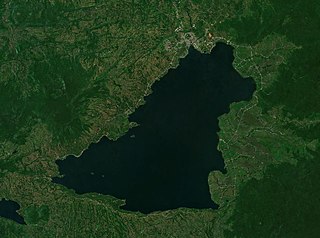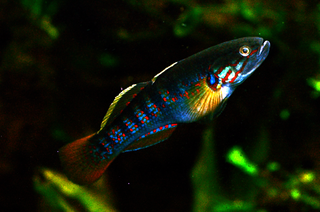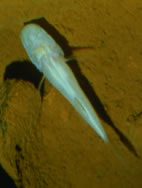
The Mexican tetra, also known as the blind cave fish, blind cave characin or the blind cave tetra, is a freshwater fish in the Characidae family of the order Characiformes. The type species of its genus, it is native to the Nearctic realm, originating in the lower Rio Grande, and the Neueces and Pecos Rivers in Texas, into the Central Plateau and eastern states of Mexico.

The Amblyopsidae are a fish family commonly referred to as cavefish, blindfish, or swampfish. They are small freshwater fish found in the dark environments of caves, springs and swamps in the eastern half of the United States. Like other troglobites, most amblyopsids exhibit adaptations to these dark environments, including the lack of functional eyes and the absence of pigmentation. More than 200 species of cavefishes are known, but only six of these are in the family Amblyopsidae. One of these, Forbesichthys agassizii, spends time both underground and aboveground. A seventh species in this family, Chologaster cornuta, is not a cave-dweller but lives in aboveground swamps.

Ancistrus is a genus of nocturnal freshwater fish in the family Loricariidae of order Siluriformes, native to freshwater habitats in South America and Panama. Fish of this genus are common in the aquarium trade where they are known as bushynose or bristlenose catfish. In the aquarium hobby they are often referred to as bushynose or bristlenose plecos instead, but this may lead to confusion as "pleco" usually is used for Hypostomus plecostomus and its allies and is often used as a catchall term for any loricariids remotely resembling that species.

Lake Lanao is a large ancient lake in the province of Lanao del Sur, Philippines. With a surface area of 340 km2 (130 sq mi), it is the largest lake in Mindanao, the deepest and second largest lake in the Philippines, and counted as one of the 15 ancient lakes in the world. Scholars have been pushing for the lake's inclusion in the UNESCO World Heritage List. The lake's native people call themselves the Maranao or Meranaw. Their name was derived from the name of the lake, meaning "the people living around the lake".

Eleotridae is a family of fish commonly known as sleeper gobies, with about 34 genera and 180 species. Most species are found in the tropical Indo-Pacific region, but there are also species in subtropical and temperate regions, warmer parts of the Americas and near the Atlantic coast in Africa. While many eleotrids pass through a planktonic stage in the sea and some spend their entire lives in the sea; as adults, the majority live in freshwater streams and brackish water. One of its genera, Caecieleotris, is troglobitic. They are especially important as predators in the freshwater stream ecosystems on oceanic islands such as New Zealand and Hawaii that otherwise lack the predatory fish families typical of nearby continents, such as catfish. Anatomically, they are similar to the gobies (Gobiidae), though unlike the majority of gobies, they do not have a pelvic sucker.

The Alabama cavefish is a critically endangered species of amblyopsid cavefish found only in underground pools in Key Cave, located in northwestern Alabama, United States in the Key Cave National Wildlife Refuge. It was discovered underneath a colony of gray bats in 1967 by researchers Robert A. Kuehne and John E. Cooper and scientifically described in 1974.

Barbodes binotatus, commonly known as the spotted barb or common barb, is a tropical species of cyprinid fish endemic to Java, Indonesia.

Astyanax jordani is a freshwater fish of the characin family of order Characiformes, native to Mexico. It is sometimes called the cave tetra, or by its local Spanish name sardina ciega.

Barbodes is a genus of small to medium-sized cyprinid fish native to tropical Asia. The majority of the species are from Southeast Asia. Many species are threatened and some from the Philippines are already extinct. A survey carried out in 1992 only found three of the endemic Barbodes species, and only two were found in 2008. Several members of this genus were formerly included in Puntius.

Garra andruzzii, a species of cyprinid fish, formerly the only species of the genus Phreatichthys, and is endemic to Somalia. This cave-adapted fish is whitish and blind. It has no scales. It is considered to have evolved in the cave environment for some two million years. Its former generic name derives from the Greek words phreasatos for spring, and ichthys for fish. It grows to a maximum length of 6.2 cm (2.4 in).
Awaous is a genus of fish in the family Gobiidae, the gobies. They are native to fresh, marine and brackish waters from Africa to the Americas.

Typhleotris madagascariensis is a species of fish in the family Milyeringidae that is endemic to Madagascar, where it is only known from underground waters in the southwestern portion of the island. This cavefish is blind and lacks pigmentation, and can reach a standard length of 8 cm (3.1 in).

The Gobiiformes are an order of fish that includes the gobies and their relatives. The order, which was previously considered a suborder of Perciformes, is made up of about 2,211 species that are divided between seven families. Phylogenetic relationships of the Gobiiformes have been elucidated using molecular data. Gobiiforms are primarily small species that live in marine water, but roughly 10% of these species inhabit fresh water. This order is composed chiefly of benthic or burrowing species; like many other benthic fishes, most gobiiforms do not have a gas bladder or any other means of controlling their buoyancy in water, so they must spend most of their time on or near the bottom. Gobiiformes means "goby-like".

Cavefish or cave fish is a generic term for fresh and brackish water fish adapted to life in caves and other underground habitats. Related terms are subterranean fish, troglomorphic fish, troglobitic fish, stygobitic fish, phreatic fish, and hypogean fish.

Barbodes montanoi is a species of cyprinid fish endemic to the island of Mindanao, the Philippines. It is commonly known as pait, pait-pait, or paitan, along with other native Barbodes species. This species can reach a length of 9 centimetres (3.5 in) TL. It is silvery greenish-gray in color and is characterized by a body pattern of two to six black dots or dashes. The fins are yellowish to reddish in color. The species is named after the French naturalist and explorer Joseph Montano.

The wildlife of the Philippines includes a significant number of endemic plant and animal species. The country's surrounding waters reportedly have the highest level of marine biodiversity in the world. The Philippines is one of the seventeen megadiverse countries and is a global biodiversity hotspot. In 2013, 700 of the country's 52,177 species were listed as threatened.

Trimma nasa, commonly called the nasal dwarfgoby or nasal pygmy goby, is a species of goby from the Western Pacific. They are small fish, averaging at around 2 cm (0.79 in) in length. They are bright orange and transparent yellow in life, with a white stripe running down from between the eyes to the upper lip and a dark brown spot at the base of the tail fin. They are usually found in large schools in the sloping or vertical drop-offs at coral reef edges.
Barbodes palavanensis is a species of freshwater ray-finned fish from the carp and minnow family, Cyprinidae which is found in the Philippines. It has been considered to be conspecific with the widespread spotted barb which is found throughout mainland south-east Asia and the Malay Archipelago. It was recorded as being abundant in two streams on the island of Palawan, alongside the newly described endemic goby, Stiphodon palavanensis and the cyprinid Rasbora everetti.
Ancistrus cryptophthalmus is a species of catfish in the family Loricariidae. It is a troglomorphic species that is native to South America and occurs only in the São Vicente and Angélica-Bezerra cave system in the Paranã River basin, which is part of the Tocantins River drainage in Brazil. The species reaches 6 cm (2.4 in) SL. Alongside Ancistrus galani and A. formoso, this species displays characteristics unusual among loricariids, such as reduced pigmentation and atrophied eyes, which are adaptations to a subterranean habitat that can be found in various types of cavefish.

Coryphopterus personatus, commonly referred to as the masked goby, is a marine species of goby found in the western-central Atlantic Ocean.














